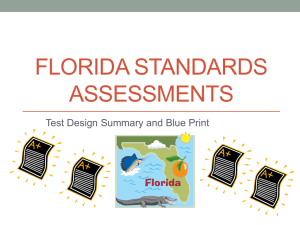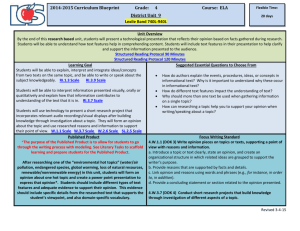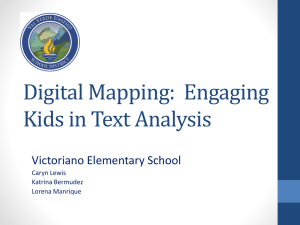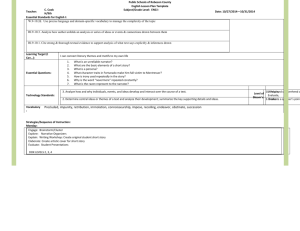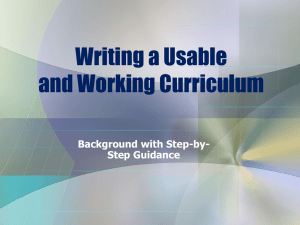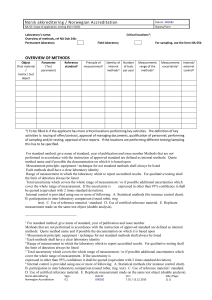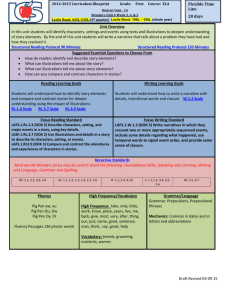Unit 8
advertisement
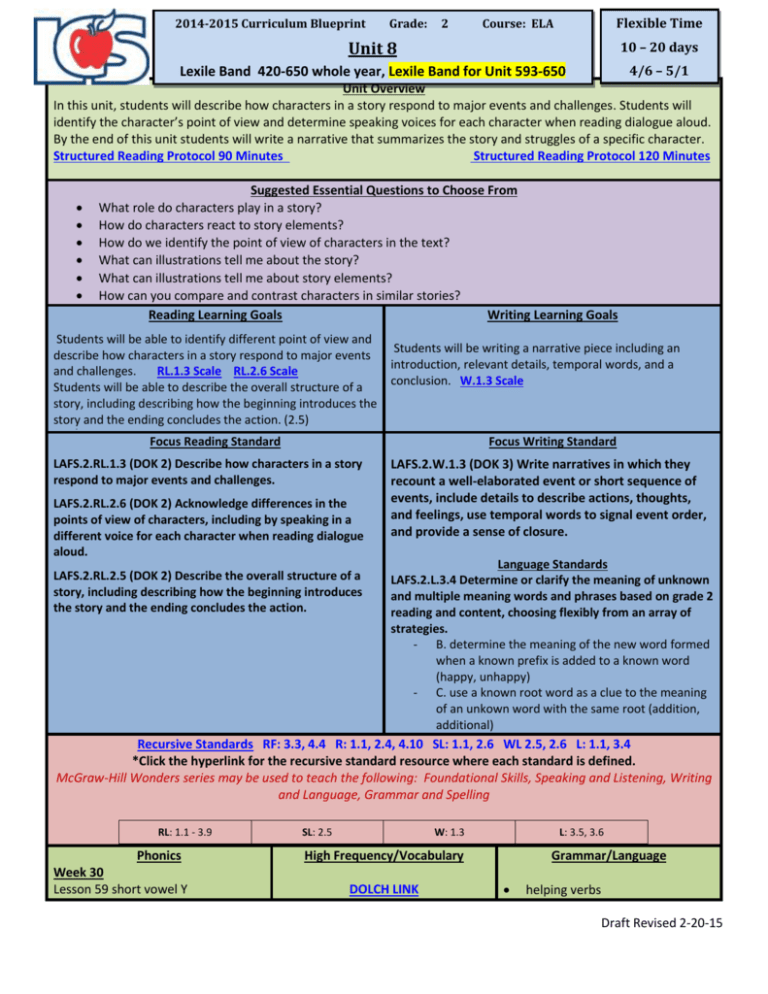
2014-2015 Curriculum Blueprint Grade: 2 Flexible Time Course: ELA Unit 8 10 – 20 days 4/6 – 5/1 Unit Overview In this unit, students will describe how characters in a story respond to major events and challenges. Students will identify the character’s point of view and determine speaking voices for each character when reading dialogue aloud. By the end of this unit students will write a narrative that summarizes the story and struggles of a specific character. Structured Reading Protocol 90 Minutes Structured Reading Protocol 120 Minutes Lexile Band 420-650 whole year, Lexile Band for Unit 593-650 Suggested Essential Questions to Choose From What role do characters play in a story? How do characters react to story elements? How do we identify the point of view of characters in the text? What can illustrations tell me about the story? What can illustrations tell me about story elements? How can you compare and contrast characters in similar stories? Reading Learning Goals Writing Learning Goals Students will be able to identify different point of view and describe how characters in a story respond to major events and challenges. RL.1.3 Scale RL.2.6 Scale Students will be able to describe the overall structure of a story, including describing how the beginning introduces the story and the ending concludes the action. (2.5) Students will be writing a narrative piece including an introduction, relevant details, temporal words, and a conclusion. W.1.3 Scale Focus Reading Standard Focus Writing Standard LAFS.2.RL.1.3 (DOK 2) Describe how characters in a story respond to major events and challenges. LAFS.2.RL.2.6 (DOK 2) Acknowledge differences in the points of view of characters, including by speaking in a different voice for each character when reading dialogue aloud. LAFS.2.W.1.3 (DOK 3) Write narratives in which they recount a well-elaborated event or short sequence of events, include details to describe actions, thoughts, and feelings, use temporal words to signal event order, and provide a sense of closure. Language Standards LAFS.2.L.3.4 Determine or clarify the meaning of unknown and multiple meaning words and phrases based on grade 2 reading and content, choosing flexibly from an array of strategies. - B. determine the meaning of the new word formed when a known prefix is added to a known word (happy, unhappy) - C. use a known root word as a clue to the meaning of an unkown word with the same root (addition, additional) Recursive Standards RF: 3.3, 4.4 R: 1.1, 2.4, 4.10 SL: 1.1, 2.6 WL 2.5, 2.6 L: 1.1, 3.4 *Click the hyperlink for the recursive standard resource where each standard is defined. McGraw-Hill Wonders series may be used to teach the following: Foundational Skills, Speaking and Listening, Writing and Language, Grammar and Spelling LAFS.2.RL.2.5 (DOK 2) Describe the overall structure of a story, including describing how the beginning introduces the story and the ending concludes the action. RL: 1.1 - 3.9 Phonics Week 30 Lesson 59 short vowel Y SL: 2.5 W: 1.3 L: 3.5, 3.6 High Frequency/Vocabulary DOLCH LINK Grammar/Language helping verbs Draft Revised 2-20-15 Week 31 Lesson 60 Y as long I, silent Y FRY LINK Review Week 32 Lesson 61 last Y rule, decoding skill 1 Week 33 Lesson 63, decoding skill 2 Deconstructed Reading Standards LAFS.2.RL.1.3 (DOK 2) Describe how characters in a story respond to major events and challenges. Define character. Define major events. Identify major events or challenges of story. Describe how characters respond to major events and challenges. 1st: Describe characters, settings, and major events in a story, using key details. 3rd: Describe characters in a story (e.g., their traits, motivations, or feelings) and explain how their actions contribute to the sequence of events. LAFS.2.RL.2.6 (DOK 2) Acknowledge differences in the points of view of characters, including by speaking in a different voice for each character when reading dialogue aloud. Recognize own point of view. Identify the characters. Identify traits of each character. Define point of view. Recognize dialogue to determine who is speaking. Analyze characters to know what type of voice to use when speaking the part. Determine differences in each character’s point of view. Read the dialogue in text using appropriate voices for different characters. 1st: Identify who is telling the story at various points in a text. 3rd: Distinguish their own point of view from that of the narrator or those of the characters. LAFS.2.RL.2.5 (DOK 2) Describe the overall structure of a story, including describing how the beginning introduces the story and the ending concludes the action. Identify the structure of the story. Describe how the beginning introduces the story. Describe the action that takes place in the middle of the story. Describe how the ending concludes the action. st 1 : Explain major differences between books that tell stories and books that give information, drawing on a wide reading of a range of text types. 3rd: Refer to parts of stories, dramas, and poems when writing or speaking about a text, using terms such as chapter, scene, and stanza; describe how each successive part builds on earlier sections. Draft Revised 2-20-15 Deconstructed Writing Standard LAFS.2.W.1.3 (DOK 3) Write narratives in which they recount a well-elaborated event or short sequence of events, include details to describe actions, thoughts, and feelings, use temporal words to signal event order, and provide a sense of closure. Identify components of a narrative including beginning and ending. Identify sequence of events. Identify details related to events. Identify temporal words. Choose relevant details that correspond to a chosen event. Reflect on identified event. Apply appropriate temporal words in order to signal change of events in a narrative. Create relevant and elaborated details to support events of a narrative. Write a narrative that recounts a well-elaborated event or short sequence of events. Write a narrative that includes supporting details, temporal words, and a sense of closure. Suggested Literary Texts *Depending on readability of text, Interactive Read-Alouds may be utilized (refer to Higher Order Questions to ensure deeper comprehension) Teach and Model The Art Lesson by Tomie Depaola (Making Meaning) Teacher’s Choice – Tomie DePaola book collection Tools and Resources for Finding Optional Texts Document-Based Questions (DBQs) When applicable ebscohost Under this link, use “Searchasaurus” Login/Password is lakecounty lexile.com lexile.com serves as a tool to assist teachers with verifying reading sources for curriculum support. Tools to measure text complexity (Vetting a text) *Students should interact with the suggested/optional texts multiple times to master the three focus reading standards within this unit. PLC’s should collaborate to determine the order of instruction and strategies that support the learning goal. Literary Tasks (Teach and Model) Choose at least 1 task per standard that will support and scaffold learning for the published product. Can be used in whole group, small group, and journal responses. 3.RL.1.3 (DOK 2) After reading a text, students will create a Thinking Map/graphic organizer to describe the main character in a story. Then, write a paragraph to describe how the character responds to major events and challenges in the text. 3.RL.1.3 (DOK 2) After reading a text, students will create a Thinking Map/graphic organizer identifying the major events in the text. Then write a response on how two of the characters from the text responded to these events. 3.RL.2.6 (DOK 3) After reading a text, students will select and record the part of the story that is told from the point of view of someone other than the main character. Discuss with a partner why you chose the parts of the story that you did and from whose point of view the selection is being told. 3.RL.2.6 (DOK 3) After reading a text, students will interpret which portion of the text is spoken from the perspective of the main character and compare that to a portion of the text that is spoken by another character. Using text evidence students will discuss their interpretations. 3.RL.3.9 (DOK 4) Using two texts of the same version, students will sequence the events of both stories using a Thinking Map/ graphic organizer. Students will write a response on how the stories are similar or different. 3.RL.3.9 (DOK 4) Using two texts, students will create a Thinking Maps/graphic organizer comparing and Draft Revised 2-20-15 contrasting the main characters. Discuss with a partner which character they liked best and why. *The tasks provided are a sampling therefore additional tasks would be required to ensure adequate practice and deepening of knowledge to ensure mastery of the focus standards. Use to create your own tasks – starting on pg.7 LDC 2-3 Template Tasks Published Product for Unit 8 *The purpose of the Published Product is to allow for students to go through the writing process with modeling. See Literary Tasks to scaffold learning and prepare students for the Published Product. Write a narrative that summarizes the story and struggles of Strega Nona. Make sure you describe the sequence of events including the characters major challenges and how she overcomes them. The writing must have a sequence of the events with details, use temporal words and have a sense of closure. Product examples starting on page 528 Higher Order Questions Link to Webb’s DOK Guide *Question stems should be utilized to create text dependent questions to encourage close reading, speaking, listening, and writing throughout the unit. LAFS.2.RL.1.3 (DOK 2) LAFS.2.RL.2.6 (DOK 3) LAFS.2.RL.3.9 (DOK 4) How did the event/challenge What do we know about the Why do you think the authors impact the character? character _? created their own version of the same story? What traits would best describe What traits would best __? What from the text supports describe __? What from the What are some of the differences your inference? text supports your inference? you notice in the two stories? How does __ (character) feel about How might __ (character) Did the authors change the main __? How is that different from __ sound/act? What from the ideas in their versions of the story? (character)? text makes you think that? Compare and contrast the How does __ (character) feel differences in the authors’ about __? How is that interpretation. different from __ (character)? Which culture (country) is How is __’s point of view represented in this story? on/about __ different form What is the relationship between __? How do you know? the two stories? What is your point of view of __ actions? What is your point of view on __? Additional Resources & Links Draft Revised 2-20-15 Marzano Proficiency Scales Bank Link to Webb’s DOK Guide LDC K-1 Template Tasks Recursive Standards Structured Reading Protocol 90 Minutes Structured Reading Protocol 120 Minutes Writing Rubric - Narrative Rubric FSA Test Item Specifications 3rd Grade ELA Test Item Specifications 5th Grade ELA Test Item Specifications 4th Grade ELA Test Item Specifications Draft Revised 2-20-15


